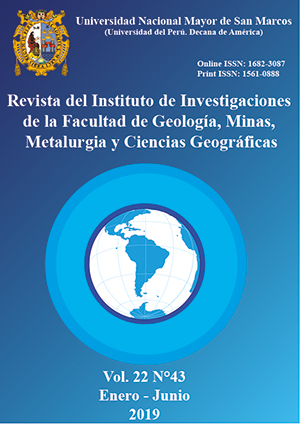Wastewater from laundry and its treatment by photocatalytic oxidation with titanium dioxide (TiO2) and ultra violet light (UV) at the National Institute of Child Health, San Borja- 2017
DOI:
https://doi.org/10.15381/iigeo.v22i43.16680Keywords:
Photocatalytic oxidation; advanced oxidation process; laundry wastewater treatment; photocatalysisAbstract
The discharges that are disposed in the sewage systems without previous treatment often contribute to the contamination of receiving bodies, mainly rivers, seas and lagoons due to their high polluting load that they carry with them, wastewater from the laundries of health centers is one of the cases that should be taken into account due to the consequences they can generate due to the presence of important contaminants present derived from the use of bio-sanitizers, cytotoxics, human remains, etc. The research carried out aimed to reduce the pollutants and main physicochemical parameters of a sample of sewage effluents from the laundry of the National Institute of Health of the child of San Borja - Lima, by means of photocatalytic oxidation technology with titanium dioxide (TiO2) and Light ultraviolet (UV). The results obtained in an experimental design are related to the concentration of TiO2, recirculation time, pH, COD, BOD and oxidation additives. It was found a maximum efficiency of improvement in the quality of wastewater with respect to the COD of 34.21% but without the presence of H2O2 and a maximum of 35.27% with the presence of H2O2.
Downloads
Published
Issue
Section
License
Copyright (c) 2019 Antony Jhon Tolentino Castillo, Elmer Benites Alfaro, Carlos Cabrera Carranza

This work is licensed under a Creative Commons Attribution-NonCommercial-ShareAlike 4.0 International License.
AUTHORS RETAIN THEIR RIGHTS:
a. Authors retain their trade mark rights and patent, and also on any process or procedure described in the article.
b. Authors retain their right to share, copy, distribute, perform and publicly communicate their article (eg, to place their article in an institutional repository or publish it in a book), with an acknowledgment of its initial publication in the Rev. Inst. investig. Fac. minas metal cienc. geogr.
c. Authors retain theirs right to make a subsequent publication of their work, to use the article or any part thereof (eg a compilation of his papers, lecture notes, thesis, or a book), always indicating the source of publication (the originator of the work, journal, volume, number and date).






